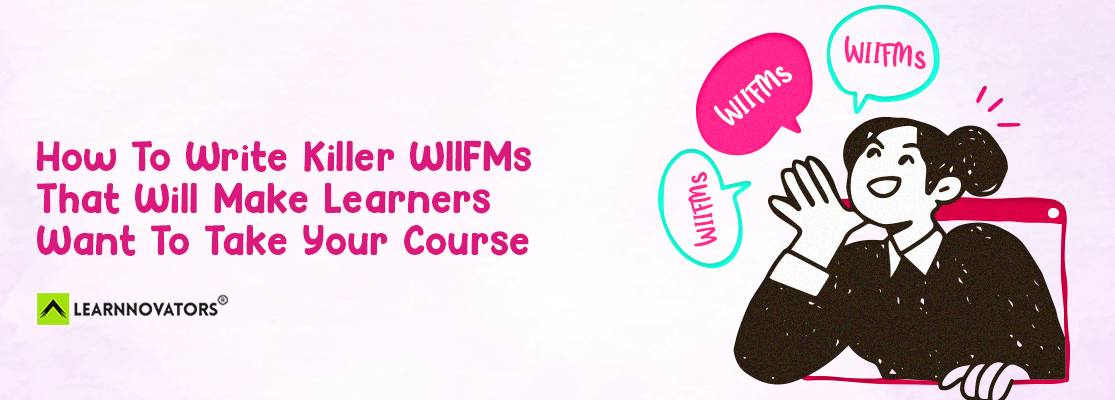If you’ve worked for any length of time in L&D, you must be familiar with the term WIIFM. You have probably brought it up in discovery sessions with the SME, or even argued about it in design review discussions with your team. But what exactly is it, and why is it important?
WIIFM is basically an acronym that expands to What’s-In-It-For-Me, and seeks to answer one simple question from the learner’s perspective – Why should I care?
Employees at all levels of an organization tend to be time poor, with a multitude of demands being placed on their focus and expertise. So, any time you ask them to take out of their busy work schedule is time that they are not being productive, and time that they are sacrificing to spend going through your program or course. And when they do commit to go through your course, they expect value for their money (which in this case, is their time).
And if you think they’re going to do it in their own time, either before or after work, think again. You will be vying for their attention with family time, social time, me time, and even Netflix and the myriad other entertainment platforms out there. You really don’t want to compete in that arena.
If you want your learners to devote time to your course in the midst of all these claims on their attention, both at work and off it, you need to communicate upfront about how the course will help them. This is where WIIFM comes in.
WIIFM is a term that is borrowed from marketing, where a product or service is positioned in such a way that its benefits are immediately clear to the prospective buyer. The buyer, in this case, is our learner. A strong WIIFM will communicate what the course is about, and how it will make their life easier or better.
I like to think of WIIFM as a two-event, two-part concept. Two-event, because there are two separate occasions in which you would need to communicate the WIIFM to the learner:
- At the start of the course, where you’re setting expectations about what to anticipate in the course; this is the one that you’re probably most familiar with, and are doing already.
- Well before the learner sets foot in (or finger on, if you will) the course, where you’re drawing attention to its existence.
Think of the WIIFM as advertising for your course. You’ve got to let them know the course exists, and you have to convince them that it’s really worth their time.
Your WIIFM should consist of two parts:
- How / how well the course will help them get better at Topic X
- Why Topic X is important
For example:
- This course will help you ask more targeted questions to customers, which can lead to more informed conversations, and hopefully to more conversions.
- On completing this module, you will better appreciate and contribute to the safety measures that are in place in your department. This will help you partake in a safe environment, for yourself and your colleagues.
In any case, make sure that the WIIFM:
- Is written from the learner’s perspective, and not from the perspective of their manager or the organization
- Makes a very specific promise to the learner
Don’t be afraid to make it as long as needed. At the end of the day, you are actually selling the course to the learner, and if it takes a few more words, by all means, go for it. At the same time, stay away from:
- Weak WIIFMs such as “List…”, “Define…”, etc. Even for a topic that they really care about, they are not interested in listing or defining stuff. So if you’ve created a course on negotiation techniques, just say that it will help them improve their bargaining game when discussing with vendors. You don’t have to present them with a laundry list of objectives, the way we’re used to doing in L&D.
- Overpromising, or making false promises. WIIFMs like “You will become 10 times more productive…” may draw in learners, but once they figure that the course is not going to deliver on that promise (let’s be honest, which course can create THAT level of transformation in anyone?), you will lose their trust forever.
- Other metrics that they don’t care about. This may be difficult for us to swallow as L&D professionals, but really, most employees don’t care if the company is going to capture 80% of the market in 5 years’ time. All they are concerned about is their WIIFM. So, even if the course is working towards the skills or abilities needed for this (improved market share) to happen, flip it around and present it in a way that answers the WIIFM for the learner.
The WIIFM is one way of communicating with your learners that you’ve thought about their needs, and that you respect their time and attention.
It is also a promise that you are making to the learner. Once you make that promise, make sure that your course delivers on it. Doing so consistently over a period of time will build trust with learners. And the more trust you build, the more open they will be to the content that you put out there.
Written by Srividya Kumar, Co-Founder @ Learnnovators








